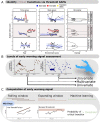Early warning signals have limited applicability to empirical lake data
- PMID: 38040724
- PMCID: PMC10692136
- DOI: 10.1038/s41467-023-43744-8
Early warning signals have limited applicability to empirical lake data
Abstract
Research aimed at identifying indicators of persistent abrupt shifts in ecological communities, a.k.a regime shifts, has led to the development of a suite of early warning signals (EWSs). As these often perform inaccurately when applied to real-world observational data, it remains unclear whether critical transitions are the dominant mechanism of regime shifts and, if so, which EWS methods can predict them. Here, using multi-trophic planktonic data on multiple lakes from around the world, we classify both lake dynamics and the reliability of classic and second generation EWSs methods to predict whole-ecosystem change. We find few instances of critical transitions, with different trophic levels often expressing different forms of abrupt change. The ability to predict this change is highly processing dependant, with most indicators not performing better than chance, multivariate EWSs being weakly superior to univariate, and a recent machine learning model performing poorly. Our results suggest that predictive ecology should start to move away from the concept of critical transitions, developing methods suitable for predicting resilience loss not limited to the strict bounds of bifurcation theory.
© 2023. The Author(s).
Conflict of interest statement
The authors declare no competing interests.
Figures






References
-
- Dakos V, Carpenter SR, van Nes EH, Scheffer M. Resilience indicators: prospects and limitations for early warnings of regime shifts. Philos. Trans. R. Soc. B Biol. Sci. 2015;370:20130263. doi: 10.1098/rstb.2013.0263. - DOI
-
- Brothers SM, et al. A regime shift from macrophyte to phytoplankton dominance enhances carbon burial in a shallow, eutrophic lake. Ecosphere. 2013;4:art137. doi: 10.1890/ES13-00247.1. - DOI
-
- Sguotti, C. & Cormon, X. Regime shifts—A global challenge for the sustainable use of our marine resources. In YOUMARES 8—Oceans bcross Boundaries: Learning from each other (eds Jungblut, S., Liebich, V. & Bode, M.) 155–166 (Springer International Publishing, 2018).
-
- Crépin A-S, Biggs R, Polasky S, Troell M, de Zeeuw A. Regime shifts and management. Ecol. Econ. 2012;84:15–22. doi: 10.1016/j.ecolecon.2012.09.003. - DOI
Publication types
MeSH terms
Grants and funding
LinkOut - more resources
Full Text Sources
Research Materials

